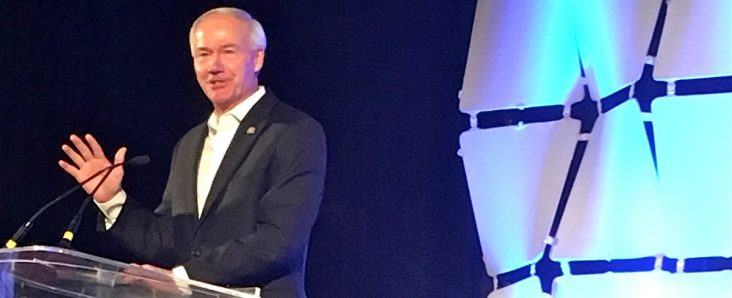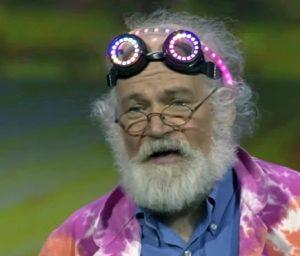NWA Tech Summit focuses on growing tech sector, benefits of digital disruption
by October 7, 2016 5:39 pm 481 views

One of the state’s biggest cheerleaders did his best to convince techies from around the country that Arkansas is a great place to grow a technology company.
Gov. Asa Hutchinson spoke at the Northwest Arkansas Technology Summit in Rogers on Friday (Oct. 7). About 1,500 tech professionals attended the summit, more than double the number from last year.
Hutchinson said Arkansas’ 3.9% unemployment rate and having the top GDP growth rate in the country in the first quarter of this year are two good reasons tech companies can locate and grow in the Natural State. He said Northwest Arkansas has become a technology center in part because Wal-Mart Stores and Tyson Foods couldn’t have become global companies without employing technology throughout their operations.
Sam Dean, executive director for the Scott Family Amazeum, issued some challenges to the local community to focus on growing the local technology sector. Dean said Northwest Arkansas should become the densest, most concentrated STEM (science, technology, engineering, and math) community in the country. Incorporating tomorrow’s workforce into the summit, more than 200 local high school students attended the summit from grants made by the Northwest Arkansas Council.
Dean followed up asking the Northwest Arkansas business community to be supportive of STEM education and be willing to take calculated risks. Hutchinson said requiring coding be taught in every Arkansas high school had some risks. But two years into the program the biggest increase in students taking computer coding is among females and minorities, Hutchinson shared to a round of applause. Of the 65 speakers at this year’s Technology Summit, just 16.9% were women and 10% were minorities.
‘DIGITAL DISRUPTIONS’
The theme of this year’s conference was “digital disruptions” and Dr. John Cohn, an IBM Fellow, who is also known as the Mad Scientist, gave the crowd a sobering look at what life might look like in 2020 in a connected world run by the Internet of Things (IoT).

Cohn said as chips continue to get smaller and less expensive they will likely help hasten the IoT world. He said IBM is now working on a chip the width of two human hairs, is connected to the cloud and a fully functional computer, encripted with security and privacy and a radio. The cost is just 2 cents. Cohn said the applications for that are huge.
“You are not going to be to able to buy a package of food at the store that is not chipped. As the price on this drops this technology is going to be incorporated into many more things. By 2020 scientist are predicting there will be 30 billion of these connected devices that relate to one another, right now there’s about 9 billion. This growth will represent $1.7 trillion in business values and tremendous opportunities,” Cohn said.
By 2020 Cohn said there will be as many connected things gathered data together equal to the stars in the known galaxies.
Cohn ran through what life might look like with IoT becomes more mainstream. He said imagine lying in bed with your wearables that check your comfort levels and track your health stats to ensure you have a good night’s sleep. The wearables tell the mattress to firm up for more support and you are awaken with a personal and calming message to great the new day. In the bathroom the toilet paper has been replenished because Kimberly Clark knows when you’re running low and automatically reorders. As you look into the mirror it checks your vital signs. As you go to the refrigerator, its notes that you chose the chocolate cake for breakfast, instead of the eggs. Knowing your health status, Cohn said, the refrigerator talks to your doctor who then cues up a prescription at the local pharmacy.
“Think about your home watching over you. That is possible today. Next your self-driving car or shared ride through Uber picks you up for work, it knows you have prescription on file so it goes by the pharmacy first. You drive through, pay with your phone, never getting out of the car,” Cohn said.
At work Cohn describes an office where robots work side-by-side with humans and he says the robot is starting to connect with his emotions.
“After work my ride senses that I need to visit with my mom whose apartment is automated with IoT. Data collected by the IoT in her home have diagnosed symptoms of Parkinson’s Disease – technology available today. And oh by the way it also tells you that she’s dating again, something you might not want to know,” Cohn said.
He said IoT will give consumer back time they spend doing some things. Shopping lists can be predicted by refrigerators or recorded by Amazon Echo. Shopping can be done online with scheduled delivery or picked up. He said Walmart’s Scan and Go and WalmartPay mean you don’t have to carry wallet in the stores today.
Cohn said the connected world is happening and there’s no putting the genie back in the bottle. The challenge for businesses he said is to know when connectedness is too invasive and creepy.
CREEPY OR CONVENIENT?
Bill Akins, senior vice president of business innovation at Rockfish, quoting Karen Ann Terrell, Chief Technology Officer at Walmart, said “One person’s creepiness is another person’s convenience.” A frequent traveler, Akins said he signed up for the TSA automatic check-in option. He said it required a grueling background search and he had to give up some privacy to get that option, but it was worth it because he travels often and it’s a time saver. Earlier this year Akins was in Michigan when he contracted the flu. He went to the hospital there to seek a diagnosis. A couple of days later he opted to fly home early and tried to check in via the TSA automatic system.
“I was denied check in because they told me I had the flu. I had to wait two more days before I could fly home. On the one hand as a passenger it’s a good thing that sick people can’t fly, but for me I realized quickly that I had given up a lot of my privacy in exchange for the automatic check-in privilege,” he shared.
It was evident at the conference how technology is intertwined into every segment of life. sectors presenting at this year’s conference included: State government, health care, retail, supply chain, logistics, small businesses, hospitality, education and finance.
